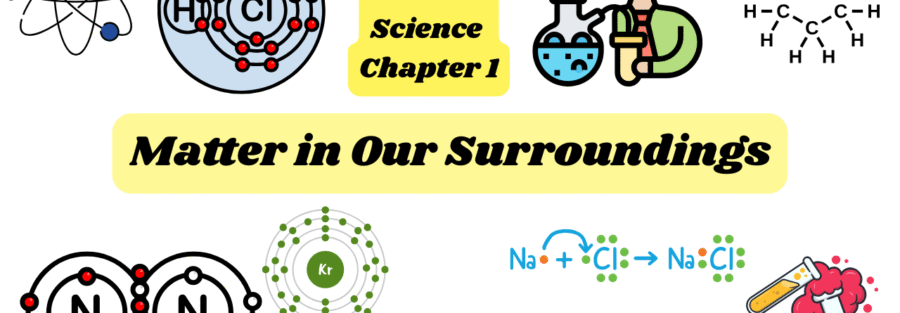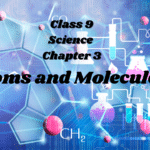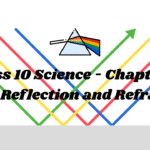Class 9 Science Chapter 1: Matter in Our Surroundings
Chapter 1: Matter in Our Surroundings – Short Notes
1. Introduction to Matter
- Matter is anything that has mass and occupies space.
- It is made up of tiny particles that are constantly moving.
2. Physical Nature of Matter
- Matter is made up of particles: These particles are very, very small.
- Particles have space between them: This is why gases can be compressed and why one substance can dissolve in another (diffusion).
- Particles are constantly moving: They possess kinetic energy. The kinetic energy increases with temperature.
- Particles attract each other: The force of attraction keeps the particles together. This force is strongest in solids and weakest in gases.
3. States of Matter
Matter exists in three states: Solid, Liquid, and Gas.
| Property | Solid | Liquid | Gas |
|---|---|---|---|
| Shape & Volume | Fixed shape and volume | Fixed volume, no fixed shape | No fixed shape or volume |
| Density | High | Moderate (less than solid) | Very Low |
| Compressibility | Negligible | Very Low | High |
| Fluidity (Flow) | Cannot flow | Can flow | Can flow easily |
| Inter-particle Forces | Strongest | Weaker than solids | Negligible |
| Kinetic Energy of Particles | Lowest | Higher than solids | Highest |
| Diffusion | Very slow | Faster than solids | Very fast |
4. Change of State
A substance can change its state by altering temperature or pressure.
- Melting (Fusion): Solid to Liquid. The temperature at which this happens is the Melting Point.
- Freezing (Solidification): Liquid to Solid. The temperature is the Freezing Point (same as melting point).
- Boiling (Vaporization): Liquid to Gas. The temperature at which this happens is the Boiling Point.
- Condensation: Gas to Liquid.
- Sublimation: Solid directly to Gas without becoming liquid (e.g., Camphor, Ammonium chloride, Naphthalene balls, Dry Ice).
5. Latent Heat
- The hidden heat absorbed or released by a substance during a change of state without a change in temperature.
- Latent Heat of Fusion: Heat required to change 1 kg of solid into liquid at its melting point.
- Latent Heat of Vaporization: Heat required to change 1 kg of liquid into vapour at its boiling point.
6. Evaporation
- The process of a liquid changing into vapour below its boiling point and from its surface.
- Factors affecting Evaporation:
- Surface Area: Increases with an increase in surface area.
- Temperature: Increases with an increase in temperature.
- Humidity: Decreases with an increase in humidity.
- Wind Speed: Increases with an increase in wind speed.
- Cooling Effect of Evaporation: When a liquid evaporates, the particles with the highest kinetic energy escape first, lowering the average kinetic energy (temperature) of the remaining particles. This causes cooling.
- Example: We feel cool when sweat evaporates from our skin.
Important Questions & Answers
Very Short Answer Type Questions (1 Mark)
1. Define matter.
Ans: Anything that has mass and occupies space is called matter.
2. Name the process by which a drop of ink spreads in a beaker of water.
Ans: Diffusion.
3. What is the physical state of water at: a) 25°C b) 0°C c) 100°C?
Ans: a) Liquid, b) Solid (Ice) or liquid, c) Gas (Steam) or liquid.
4. What is the SI unit of temperature?
Ans: Kelvin (K).
5. What is the boiling point of water at one atmospheric pressure?
Ans: 100°C (373 K).
6. Why do we see water droplets on the outer surface of a glass containing ice-cold water?
Ans: The water vapour present in the air comes in contact with the cold outer surface of the glass, loses energy, and condenses into liquid water droplets.
7. What is the common name of the process where a solid directly changes into a gas?
Ans: Sublimation.
Short Answer Type Questions (2-3 Marks)
1. Why does the temperature remain constant during the melting of ice?
Ans: The temperature remains constant during melting because the heat energy supplied is used to overcome the forces of attraction between the particles of ice (latent heat of fusion). This energy breaks the rigid structure of the solid into a liquid without increasing the kinetic energy (and hence the temperature).
2. How does evaporation cause cooling?
Ans: During evaporation, the particles of the liquid absorb energy from the surroundings to overcome the force of attraction and change into vapour. The particles that leave the surface of the liquid are the ones with higher kinetic energy. The loss of these high-energy particles lowers the average kinetic energy of the remaining particles, thus lowering the temperature and causing cooling.
3. Why do gases have high compressibility but not solids?
Ans: Gases have very large inter-particle spaces. When pressure is applied, these particles can be forced closer together, reducing the volume. In solids, the particles are tightly packed with very little space between them, making them incompressible.
4. Why do we wear cotton clothes in summer?
Ans: Cotton is a good absorber of water (sweat). During summer, we sweat more. The sweat is absorbed by the cotton cloth and spreads over a large surface area, leading to faster evaporation. This evaporation causes cooling, making us feel comfortable.
5. Convert the following temperatures to the Kelvin scale: a) 25°C b) 373°C
Ans: To convert °C to K, we use the formula: K = °C + 273
a) 25°C = 25 + 273 = 298 K
b) 373°C = 373 + 273 = 646 K
Long Answer Type Questions (5 Marks)
1. Compare the properties of solids, liquids, and gases.
Ans: (Refer to the table in the short notes section for a detailed answer). Mention properties like shape, volume, density, compressibility, fluidity, inter-particle forces, and kinetic energy.
2. a) What is latent heat? Differentiate between latent heat of fusion and latent heat of vaporization.
b) How can you show that water vapour is present in the air?
Ans:
a) Latent Heat: The heat energy required to change the state of a substance without a change in temperature is called latent heat.
- Latent Heat of Fusion: Heat energy required to change 1 kg of a solid into liquid at atmospheric pressure at its melting point.
- Latent Heat of Vaporization: Heat energy required to change 1 kg of a liquid into vapour at atmospheric pressure at its boiling point.
b) Take a glass full of ice-cold water and leave it on a table. After some time, we will observe water droplets on the outer surface of the glass. This happens because the water vapour present in the air comes in contact with the cold surface of the glass, loses energy, and gets converted to liquid water (condensation). This proves the presence of water vapour in the air.
3. Describe an activity to show that the rate of evaporation increases with an increase in surface area.
Ans:
- Aim: To show the effect of surface area on evaporation.
- Materials: Two Petri dishes/plates, same volume of water.
- Procedure:
- Take two Petri dishes. Label them A and B.
- Pour 10 ml of water in dish A and 10 ml of water in dish B.
- Leave dish A as it is (small surface area). Spread the water from dish B with a spoon to create a larger surface area.
- Leave both dishes in the same place for some time.
- Observation: The water in dish B (with a larger surface area) will evaporate completely faster than the water in dish A.
- Conclusion: The rate of evaporation increases with an increase in surface area.
Good luck with your studies
Of course! Here are concise and well-organized short notes and important questions for Class 9 Science Chapter 1 in Hindi.
अध्याय 1: हमारे आस-पास के पदार्थ – संक्षिप्त नोट्स (Short Notes)
1. पदार्थ का परिचय
- पदार्थ वह है जिसमें द्रव्यमान होता है और स्थान घेरता है।
- यह छोटे-छोटे कणों से मिलकर बना होता है जो लगातार गति करते रहते हैं।
2. पदार्थ की भौतिक प्रकृति
- पदार्थ कणों से बना है: ये कण अत्यंत सूक्ष्म होते हैं।
- कणों के बीच रिक्त स्थान होता है: इसीलिए गैसों को संपीडित किया जा सकता है और विसरण (diffusion) होता है।
- कण निरंतर गतिशील रहते हैं: उनमें गतिज ऊर्जा होती है, जो तापमान बढ़ने पर बढ़ती है।
- कण एक-दूसरे को आकर्षित करते हैं: यह आकर्षण बल कणों को एक साथ बनाए रखता है। यह बल ठोस में सबसे प्रबल और गैस में सबसे दुर्बल होता है।
3. द्रव्य की अवस्थाएँ
पदार्थ तीन अवस्थाओं में पाया जाता है: ठोस, द्रव और गैस।
| गुण | ठोस | द्रव | गैस |
|---|---|---|---|
| आकार एवं आयतन | निश्चित आकार और आयतन | निश्चित आयतन, अनिश्चित आकार | अनिश्चित आकार और आयतन |
| घनत्व | उच्च | मध्यम (ठोस से कम) | अत्यंत निम्न |
| संपीड्यता | नगण्य | बहुत कम | उच्च |
| प्रवाहित होने की क्षमता | प्रवाहित नहीं हो सकते | प्रवाहित हो सकते हैं | आसानी से प्रवाहित हो सकते हैं |
| अंतरा-कण आकर्षण बल | सबसे प्रबल | ठोस से दुर्बल | नगण्य |
| कणों की गतिज ऊर्जा | न्यूनतम | ठोस से अधिक | सर्वाधिक |
4. अवस्था परिवर्तन
तापमान या दाब बदलकर पदार्थ की अवस्था बदली जा सकती है।
- गलन (Melting): ठोस से द्रव। जिस तापमान पर यह होता है उसे गलनांक कहते हैं।
- हिमीकरण (Freezing): द्रव से ठोस। इसका तापमान हिमांक (गलनांक के बराबर) होता है।
- क्वथन (Boiling): द्रव से गैस। जिस तापमान पर यह होता है उसे क्वथनांक कहते हैं।
- संघनन (Condensation): गैस से द्रव।
- उर्ध्वपातन (Sublimation): बिना द्रव बने सीधे ठोस से गैस में बदलना (उदा., कपूर, अमोनियम क्लोराइड)।
5. गुप्त ऊष्मा
- वह छुपी हुई ऊष्मा जो अवस्था परिवर्तन के दौरान बिना तापमान बदले अवशोषित या मुक्त होती है।
- संगलन की गुप्त ऊष्मा: 1 kg ठोस को उसके गलनांक पर द्रव में बदलने के लिए आवश्यक ऊष्मा।
- वाष्पन की गुप्त ऊष्मा: 1 kg द्रव को उसके क्वथनांक पर वाष्प में बदलने के लिए आवश्यक ऊष्मा।
6. वाष्पन
- वह प्रक्रिया जिसमें एक द्रव अपने क्वथनांक से कम तापमान पर और अपनी सतह से वाष्प में बदलता है।
- वाष्पन को प्रभावित करने वाले कारक:
- सतह का क्षेत्रफल: सतह का क्षेत्रफल बढ़ने पर वाष्पन बढ़ता है।
- तापमान: तापमान बढ़ने पर वाष्पन बढ़ता है।
- आर्द्रता: आर्द्रता बढ़ने पर वाष्पन घटता है।
- वायु की गति: वायु की गति बढ़ने पर वाष्पन बढ़ता है।
- वाष्पन का शीतलन प्रभाव: जब कोई द्रव वाष्पित होता है तो उच्चतम गतिज ऊर्जा वाले कण पहले पलायन करते हैं, जिससे बचे हुए कणों की औसत गतिज ऊर्जा (तापमान) कम हो जाती है। इससे शीतलता होती है।
- उदाहरण: पसीना सूखने पर हमें ठंडक महसूस होती है।
महत्वपूर्ण प्रश्न एवं उत्तर (Important Questions & Answers)
अति लघु उत्तरीय प्रश्न (1 अंक)
1. पदार्थ को परिभाषित करें।
उत्तर: वह सब कुछ जिसमें द्रव्यमान हो और स्थान घेरता हो, पदार्थ कहलाता है।
2. वह प्रक्रिया क्या है जिससे जल की एक बूंद बीकर के पानी में फैल जाती है?
उत्तर: विसरण (Diffusion)।
3. निम्नलिखित पर जल की भौतिक अवस्था क्या है: a) 25°C b) 0°C c) 100°C?
उत्तर: a) द्रव, b) ठोस (बर्फ) या द्रव, c) गैस (भाप) या द्रव।
4. तापमान का SI मात्रक क्या है?
उत्तर: केल्विन (K)।
5. एक वायुमंडलीय दाब पर जल का क्वथनांक क्या है?
उत्तर: 100°C (373 K)।
6. बर्फ वाले ठंडे पानी से भरे गिलास की बाहरी सतह पर पानी की बूंदें क्यों दिखाई देती हैं?
उत्तर: हवा में मौजूद जलवाष्प गिलास की ठंडी बाहरी सतह के संपर्क में आती है, ऊर्जा खो देती है और संघनित होकर पानी की बूंदों में बदल जाती है।
7. उस प्रक्रिया का सामान्य नाम क्या है जहाँ एक ठोस सीधे गैस में बदल जाता है?
उत्तर: उर्ध्वपातन (Sublimation)।
लघु उत्तरीय प्रश्न (2-3 अंक)
1. बर्फ के पिघलने के दौरान तापमान स्थिर क्यों रहता है?
उत्तर: पिघलने के दौरान तापमान स्थिर रहता है क्योंकि आपूर्ति की गई ऊष्मा ऊर्जा बर्फ के कणों के बीच के आकर्षण बलों (गुप्त ऊष्मा) पर काबू पाने के लिए उपयोग होती है। यह ऊर्जा ठोस की दृढ़ संरचना को तोड़कर द्रव में बदल देती है बिना गतिज ऊर्जा (और इसलिए तापमान) बढ़ाए।
2. वाष्पन ठंडक कैसे पैदा करता है?
उत्तर: वाष्पन के दौरान, द्रव के कण आकर्षण बल पर काबू पाने और वाष्प में बदलने के लिए परिवेश से ऊर्जा अवशोषित करते हैं। द्रव की सतह को छोड़ने वाले कण उच्च गतिज ऊर्जा वाले होते हैं। इन उच्च-ऊर्जा वाले कणों के निकल जाने से बचे हुए कणों की औसत गतिज ऊर्जा कम हो जाती है, जिससे तापमान कम होता है और ठंडक होती है।
3. गैसों में संपीड्यता अधिक क्यों होती है लेकिन ठोसों में नहीं?
उत्तर: गैसों में कणों के बीच बहुत large रिक्त स्थान होते हैं। जब दबाव लगाया जाता है, तो इन कणों को एक-दूसरे के closer धकेला जा सकता है, जिससे आयतन कम हो जाता है। ठोसों में, कणों के बीच बहुत कम जगह होती है, जिससे वे असंपीड्य होते हैं।
4. हम गर्मियों में सूती कपड़े क्यों पहनते हैं?
उत्तर: सूती कपड़ा पानी (पसीना) का अच्छा अवशोषक होता है। गर्मियों में, हमें अधिक पसीना आता है। पसीना सूती कपड़े द्वारा अवशोषित कर लिया जाता है और एक बड़े surface area पर फैल जाता है, जिससे वाष्पन तेज होता है। यह वाष्पन ठंडक पैदा करता है, जिससे हमें आराम महसूस होता है।
5. निम्नलिखित तापमान को केल्विन पैमाने में बदलें: a) 25°C b) 373°C
उत्तर: °C को K में बदलने के लिए: K = °C + 273
a) 25°C = 25 + 273 = 298 K
b) 373°C = 373 + 273 = 646 K
दीर्घ उत्तरीय प्रश्न (5 अंक)
1. ठोस, द्रव और गैस के गुणों की तुलना करें।
उत्तर: (संक्षिप्त नोट्स अनुभाग में दी गई तालिका देखें)। आकार, आयतन, घनत्व, संपीड्यता, प्रवाहिता, अंतरा-कण बल और गतिज ऊर्जा जैसे गुणों का उल्लेख करें।
2. a) गुप्त ऊष्मा क्या है? संगलन की गुप्त ऊष्मा और वाष्पन की गुप्त ऊष्मा में अंतर बताएं।
b) आप कैसे दिखाएंगे कि हवा में जलवाष्प मौजूद है?
उत्तर:
a) गुप्त ऊष्मा: किसी पदार्थ की अवस्था बदलने के लिए आवश्यक ऊष्मा ऊर्जा, बिना तापमान बदले, गुप्त ऊष्मा कहलाती है।
- संगलन की गुप्त ऊष्मा: 1 kg ठोस को उसके गलनांक पर द्रव में बदलने के लिए आवश्यक ऊष्मा ऊर्जा।
- वाष्पन की गुप्त ऊष्मा: 1 kg द्रव को उसके क्वथनांक पर वाष्प में बदलने के लिए आवश्यक ऊष्मा ऊर्जा।
b) एक गिलास ठंडा पानी लें और उसे एक मेज पर रख दें। कुछ देर बाद, हम गिलास की बाहरी सतह पर पानी की बूंदें देखेंगे। ऐसा इसलिए होता है क्योंकि हवा में मौजूद जलवाष्प गिलास की ठंडी सतह के संपर्क में आती है, ऊर्जा खो देती है और द्रव जल में परिवर्तित हो जाती है (संघनन)। यह हवा में जलवाष्प की उपस्थिति साबित करता है।
3. एक गतिविधि describe करें जो दर्शाती है कि surface area बढ़ने पर वाष्पन की दर बढ़ जाती है।
उत्तर:
- उद्देश्य: वाष्पन पर surface area के प्रभाव को दिखाना।
- सामग्री: दो पेट्री डिश/प्लेट, पानी की समान मात्रा।
- विधि:
- दो पेट्री डिश लें। उन पर A और B अंकित करें।
- डिश A में 10 ml पानी डालें और डिश B में भी 10 ml पानी डालें।
- डिश A को यूं ही छोड़ दें (छोटा surface area)। डिश B के पानी को एक चम्मच से फैला दें ताकि surface area बढ़ जाए।
- दोनों डिश को एक ही जगह पर कुछ समय के लिए छोड़ दें।
- अवलोकन: डिश B का पानी (बड़े surface area वाला), डिश A के पानी की तुलना में पहले पूरी तरह वाष्पित हो जाएगा।
- निष्कर्ष: surface area बढ़ने पर वाष्पन की दर बढ़ जाती है।



